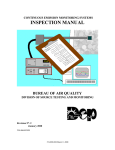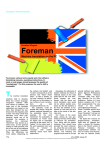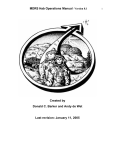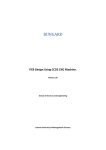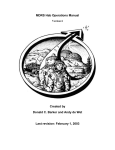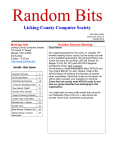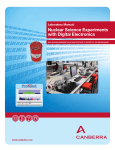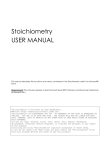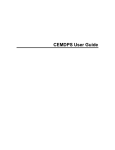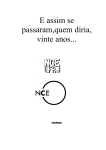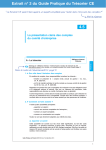Download Fall 2001 - Vernier Software & Technology
Transcript
V E R N I E R V E SR ON IF E TR WS AO FR T E W A& R E T &E CT EH C NH ON OL LO O GG Y Vernier The Caliper is a publication for users of Vernier products The Caliper Volume 18 Number 2 Fall 2001 A New Spectrophotometer Program! Our newest data acquisition program, Spectro Pro, allows you to collect and analyze data from several different spectrophotometers. The Spectronic 20D or D+, Genesys 20, or Flinn Spectrophotometer can be connected directly to a PC or Macintosh® serial port using the appropriate cable. The analog spectrophotometers, Spectronic 20 and 20+, can be connected to the computer through an interface—a Vernier LabPro®, ULI, or Serial Box Interface. With the spectrophotometer connected to your computer’s serial port, you can ■ collect absorbance vs. time data for kinetics studies. ■ collect absorbance vs. concentration data to produce a Beer’s law graph or determine the concentration of an unknown by interpolation. ■ collect absorbance vs. wavelength data to produce an absorption spectrum. ■ view data graphed in real time. ■ easily calibrate the spectrophotometer by following on-screen prompts. ■ create calculated spreadsheet columns, perform curve fits on data, and do statistical analysis of data. IN THIS ISSUE Spectro Pro Nuclear Radiation with Computers and Calculators We used Spectro Pro to perform a spectral analysis of the pigment extracted from autumn leaves. After soaking the leaves in rubbing alcohol for two days, cuvettes were filled with the extract solution. We used wavelengths of 400 nm to 700 nm and we plotted the absorbance values. The graph above shows the compilation of data for four different colored leaves. Thanks to Jack Sipe, Tracy Schoolcraft, Paula Rupert, and Gregory Anderson of the Advancing Science Program at Gettysburg College for the lab idea. You can request a copy of the experiment procedure from their web site at http://advancingscience.org. Spectro Pro (Includes site license for both Windows® and Macintosh) ................ Order Code SP .............. $50 (See page 5 for information about cables for spectrophotometers.) More Awards for Our Products Vernier Training CD Use LabVIEW™ with LabPro Innovative Uses Workshops Vernier LabPro received a 2001 Award of Excellence from Technology & Learning magazine. The awards were presented at the School Technology Expo in Chicago in October. T H E The September 2001 eSchool News Readers’ Choice Awards rated Vernier Graphical Analysis as the most popular of all grade 9-12 science software. C A L I P E R • F A L L 2 0 0 1 1 V E R N I E R S O F T W A R E Free Vernier Training CD Are you not sure how to get started with our products? Do you want free training? Do you think you want to buy, but you want to see LabPro in action first? You can get all of that with our free “Getting Started with Vernier” CD! Last summer, we filmed our tech support staff performing 42 experiments from our lab books. These experiments can now be seen in one action-packed video. The “Getting Started with Vernier” CD includes the following: ■ Overviews of our products ■ How to set up LabPro ■ Software installation ■ Demonstrations of calculator and computer experiments ■ Our complete catalog in PDF format & T E C H N O L O G Y Do-it-Yourself Programming with LabPro in LabVIEW™, Visual BASIC® or REALbasic® Over the years, we have always supported and encouraged people who enjoy programming to use our lab interfaces for custom programming. We have recently completed sample programs to help you program for LabPro using three very different environments: ■ LabVIEW—a graphical programming language used extensively in research and industry. A sample program for LabVIEW is called a virtual instrument, or VI. ■ Visual BASIC—the most popular programming language for Windows. ■ REALbasic—a language very similar to Visual Basic, but for Macintosh. The sample programs will help you get started in writing your own programs for collecting and analyzing LabPro data. For each programming language, the samples include the following types of data collection: ■ slow analog (real time) ■ fast analog (non-real time) ■ Motion Detector New users, veteran users, or anyone who wants to learn more about our products will find useful information in this video training guide. If you would like a free copy of this CD, simply send an e-mail that includes your complete mailing address to [email protected]. Logger Pro Goes International ® If you received a Vernier Logger Pro CD recently, you may have noticed that during installation, you are now asked whether you want to install the English, French, Italian, or Spanish version of Logger Pro. That’s right! You can now collect data in one of four languages with the Windows version, or two languages with our Macintosh version (French and English). We have had many requests for international versions over the years, and this is our first step in that direction. We have even included international versions of the Logger Pro User’s Manual, Logger Pro Tutorial, and LabPro User’s Manual on the CD. Will other international versions follow? Probably not for at least a year. But we do feel we have made a good start that will be valuable for our French-, Italian-, and Spanish-speaking teachers and students. If you are interested in examining or using these international versions, do the following: ■ Check your current Logger Pro CD label. If it says “Version 2.1.1 International,” your CD has the new versions. ■ If you have the English version of Logger Pro on your computer, but want to install a French, Italian, or Spanish version, go to our web site, click on the link Logger Pro 2.1.1 Update at the lower left of the home page, then click on the link to International Upgrades to Logger Pro 2.1.1. ■ Photogate ■ other digital inputs In addition, we have samples showing digital output (for use with the DCU, for example) and analog output (-5 to +5 V). These sample programs and VIs are available free on our web site at www.vernier.com. Click on the “Downloads” button. Also available on our web site is the LabPro Technical Reference Manual with all the details of how LabPro is controlled by programs. Activities for Middle Grades Science with the CBL 2™ and the TI-73 by Debbie Crawford, Ray Leonard, and Cathy Roberts This new book from Texas Instruments contains 22 middle school science investigations that provide hands-on data collection with a variety of sensors, including temperature, pH, force, motion, voltage, and light. Physical science is explored through properties of matter, motion and force, and transfer of energy. Life science activities investigate living systems, populations and ecosystems, and diversity and adaptations of organisms. The book also provides earth and space science activities. Even though Activities for Middle Grades Science with the CBL 2 and the TI-73 was written for the CBL 2, you can also use it unchanged with the Vernier LabPro interface. Order Code TI-MGS ............................................................................ $20 2 T H E C A L I P E R • F A L L 2 0 0 1 V E R N I E R S O F T W A R E & T E C H N O L O G Y Nuclear Radiation with Computers and Calculators By John Gastineau Nuclear Radiation with Computers and Calculators, which was introduced earlier this year, includes some exciting new experiments for physics, chemistry, and physical science teachers. Each of the six experiments has a computer version (for LabPro or ULI) and a calculator version (for LabPro or CBL 2). The Nuclear Radiation CD included with the book contains the word processing files for the six student experiments: determine the background count rate from the combination of cosmic rays and leaked cesium. (With time, isogenerators will sometimes leak small amounts of the cesium-137 isotope.) The calculator data below show an exponential fit done after background levels are subtracted from the data. The decay rate value of 0.00444 s-1 yields a half-life value of 156 seconds, or 2.60 minutes. ■ Alpha, Beta, and Gamma ■ Distance and Radiation ■ Lifetime Measurement ■ Counting Statistics ■ Background Radiation Sources ■ Radiation Shielding In each of these experiments, you can use either the Vernier Radiation Monitor or the Student Radiation Monitor. The six experiments cover a broad spectrum of topics in high school and college nuclear radiation curriculum. One of our favorites is Lifetime Measurement. In this experiment, students use a source called an isogenerator that contains cesium-137, which decays to an isotope with a short half-life, barium-137. Using a simple chemical separation process, the isogenerator allows you to easily remove a sample of barium with a half-life of 2.552 minutes by gamma emission, making this system an ideal one for classroom study. A 30-minute experimental run covers almost 12 half-lives, so the observed activity drops to about 0.3% of the initial value. The cesium-137 source in the isogenerator will last for years and can be reused many times. Nuclear Radiation with Computers and Calculators Order Code NRCC ............................................................................................. $25 Student Radiation Monitor (detects β and γ only) Order Code SRM-BTD .................................................................................... $145 Radiation Monitor (detects α, β, and γ) Order Code RM-BTD ....................................................................................... $205 Fifteen and Ten Years Ago in this Newsletter… In the fall of 1986: Our How to Build a Better Mousetrap book of science projects for use with an Apple II computer was released. We reported on the compatibility of our products with the new Apple IIGS and Laser 128 computers. In the fall of 1991: We announced the Macintosh version of our popular Graphical Analysis program. Amazingly, we are still selling a version of this program based on the same code. It will soon be replaced by a completely new version. We also announced our Sound program for ULI and a ULI Starter Stack, which was the first of our projects to help teachers and students develop their own software to operate our interfaces. That trend continues today, with several projects listed in this newsletter for developing programs for LabPro (see page 2). Science Humor Shown here are some sample data from this experiment. Notice that the exponential curve fit done on the first 15 minutes of data yields a decay constant equal to 0.277 min-1 (the value of C in the curve fit). Using the formula t1/2 = ln 2 / λ, the half-life, t1/2, is found to be 2.50 minutes for these data. The final five minutes of data can be used to Heisenberg is out for a drive when he’s stopped by a police officer. The officer says, “Do you know how fast you were going?” Heisenberg says, “No, but I know where I am.” T H E C A L I P E R • F A L L 2 0 0 1 3 V E R N I E R S O F T W A R E & T E C H N O L O G Y Workshops The Activity-Based Physics Institutes Session I (Starter): June 16-28,2002 Session II (Follow-up): June 15-27, 2003 These NSF-sponsored institutes will be offered in the summers of 2002 and 2003 at University of Oregon and Dickinson College for high school teachers of physics and/or physical science and school administrators. Teams are especially welcome. Adapt activity-based curricula to standards and implement new teaching methods based on physics education research. $1000 stipend, free room and board, up to $150 travel, and graduate credit or CEUs. Consult ABPI web site at http://physics.dickinson.edu/ABPInstitutes or contact Gail Oliver, Department of Physics & Astronomy, Dickinson College, [email protected]. Application deadline is February 15, 2002. Explorations in Physics A Project-Centered Curriculum for Non-Scientists, Dickinson College, Carlisle, PA, July 7-12, 2002. This seminar is designed for instructors at colleges and universities who teach physics to students whose interests lie outside the sciences. Participants will receive hands-on instruction using computer tools for data collection and strategies for overcoming implementation barriers. Free tuition, room, board, and sample curricular materials will be provided. For more information and application materials check http://physics.dickinson.edu/ EiPWkshp or contact Gail Oliver at (717) 245-1845 or [email protected]. Application deadline is March 15, 2002. More Physics Workshops More information about the following workshops can be found in the “Workshops” section of our web site or from David Sokoloff, Dept. of Physics, University of Oregon, [email protected]. RealTime Physics I: Activity-Based Learning of Mechanics and Thermodynamics in Lab. Winter AAPT Meeting, January 20, 2002, Philadelphia, PA. A half-day, hands-on workshop designed for those interested in making learning in their introductory course more active. Interactive Lecture Demonstrations I: Active Learning of Mechanics and Thermodynamics in Lecture. Winter AAPT Meeting, January 20, 2002, Philadelphia, PA. This half-day, hands-on workshop will introduce the participants to the use of Interactive Lecture Demonstrations (ILDs) to promote active learning in lecture. Chautauqua Short Courses: Promoting Active Learning in Introductory Physics Courses I. June 6-8, 2002, University of Oregon, Eugene, OR. Chautauqua Short Course: Promoting Active Learning in Introductory Physics Courses II. May 9-11, 2002. Dickinson College, Carlisle, PA. NSF-sponsored Chautauqua courses designed for those interested in making major changes in introductory physics courses or in other introductory science courses. The focus of Course I is on first semester topics. The focus of Course II is on second semester topics: electricity, magnetism, waves, and optics. 4 T H E C A L I P E R • F A L L 2 0 0 1 Vernier workshop participants at The Overlake School, Redmond, WA Pittcon 2002 Pittcon 2002 will be held in New Orleans, LA from March 16-22, 2002. It is one of the largest scientific conventions in the world, with 1000 exhibitors and more than 30,000 attendees. Their outreach to educators, called “Pittcon 2002 Science Week,” will offer a variety of programs for science teachers. Vernier will be conducting two handson workshops as part of the activities. Pittcon 2002 New Orleans, Louisiana March 17-18, 2002 Applications due December 31, 2001. See www.pittcon.org and click on “Science Week” for more information. Vernier Hands-On Chemistry Workshops at BCCE The Biennial Conference on Chemical Education will be held at Western Washington University in Bellingham, WA on July 28-Aug. 1, 2002. Vernier will be conducting several hands-on workshops. See http://chem.wwu.edu/acs/bcce. Vernier Hands-On Workshops at NSTA–San Diego We will be offering free hands-on training in 10 sessions at NSTA in San Diego, March 27-30. The workshops will cover a variety of subject areas: chemistry, physics, biology, middle school science, and water quality. And Speaking of Workshops… The Project PHYSLab series of workshops has ended, but the leaders have put together two CDs of PHYSLab workshop materials. The CDs are modestly priced and include Advanced Placement exams and problems, Interactive Physics examples, experimental work done by the 2001 Project PHYSLab participants, labs, course material, and tests from Ken Appel, Pete Parlett, and Lowell Herr. For complete details and ordering information, check out the following: www.users.qwest.net/~lherr/CD.htm. V E R N I E R S O F T W A R E Innovative Uses In an article in the October 2001 issue of The Physics Teacher, Eric Gettrust (LaFollette HS, Madison, WI) described a great way to show both Newton’s third law and action at a distance. The article is titled “An Extraordinary Demonstration of Newton’s Third Law.” He uses a magnet attached to one force sensor and a steel clip attached to another force sensor and shows the equal magnitude and oppositely directed forces. The same October issue included an article by Brian Martin (King’s College, Edmonton, Canada) entitled “Measuring the Speed of Sound–Variation on a Familiar Theme.” His method for measuring the speed of sound is an innovative one, and a great use of the FFT feature of Logger Pro. Barbara Pecori (Bologna University, Italy) and Giacomo Torzo (Padova University, Italy) used CBLs to do an elaborate and detailed study, “The Physics of the Seesaw,” which is described in the November 2001 The Physics Teacher. & T E C H N O L O G Y Controlled Ecological Mouse Support System Gus Frederick with the Oregon Public Education Network has come up with a fascinating idea that ties into the Millennium Mars Project, a project supported by NASA and the U.S. Department of Education. The goal of this project is to design a viable Martian colony. Participants are further required to produce a visual representation of their design. Gus took this idea a step further and built a smallscale working model of such a colony using mice rather than people. His “Controlled Ecological Mouse Support System” (CEMSS) is a self-contained system, designed to fully support a mouse for one-week “mouse missions.” An important part of the system is a set of sensors used to monitor temperature, carbon dioxide gas, oxygen gas, pH, and relative humidity. Gus is using LabPro, Logger Pro software, and Vernier sensors to make these measurements. He has developed an excellent web site at http://chapters.marssociety.org/or/cemss/. Mercury Phase-Out Steve Abitz and John Sebranek (Southwest HS, Green Bay, WI) took our LabPro, a calculator, and a temperature probe to Death Valley, CA in July. The average temperature in the air was 118ºF (47.8ºC). The average temperature on the ground was 125ºF (51.7ºC). Teacher Wins Award Using Vernier Products David Svrcek, who teaches 7th grade at Miller Junior HS in Aberdeen, Washington, is one of five Washington State teachers selected to receive the “2000-2001 Innovation in Teaching Award” sponsored by Battelle and Digital Blackboard. As part of their winning project, David and his students have been using Vernier LabPro and water quality sensors to collect data and monitor the health of Shannon Slough. The $2,000 awards are given to teachers using technology to teach mathematics and science in innovative ways. Congratulations David! In October, Oregon joined a number of other states in passing legislation to phase out the use of instructional materials containing mercury by public schools. For more information of similar legislation in other states, see www.mercury-k12.org. Mercury is dangerous and hard to clean up. We think this is one more reason for switching to electronic temperature measurement devices, such as our Stainless Steel Temperature Probe. Ghostly Data Collection Our Motion Detector and Magnetic Field Sensor were used and shown on camera in the Discovery Channel program Ghost Detectives. This study of the paranormal (some of us would call it pseudoscience) attempted to detect ghosts moving around at night in an old lighthouse. They did not find any, but this was not due to any failure of our equipment. Spectrophotometer Cables Flinn Spectrophotometer ..... SPC-FLI (PC) or SPC-FLM (MAC) ......................... Spec 20D or D+ ................... SPC-IBM (PC) or SPC-MAC (MAC) ...................... Spec 20 Genesys ................. GEN-PC (PC) or GEN-MAC (MAC) ........................ Spec 20 or 20+ .................... SPC-DIN (for ULI, SBI) or SPC-BTA (for LabPro) .... T H E C A L I P E R • F A L L $25 $25 $25 $25 2 0 0 1 5 V E R N I E R S O F T W A R E & Technical FAQs on Vernier Web Site We now have the answers to over 150 technical questions on our web site, including tips, tricks, troubleshooting guides, and links to product updates. We will be adding more information to this new section of our site all the time, so if you need answers to any of your technical questions, check out our new Tech Info Library (TIL) at www.vernier.com/til. Blue Light Specials No, this isn’t KMart, but have we got some bargains for you! Even though LabPro and CBL 2 are replacing the Universal Lab Interface (ULI) and original CBL, we still have some ULIs and CBLs in stock. If you are on a limited budget or want to supplement the equipment that you already have, now is a good time to snap up these interfaces. The ULI is also perfect for teachers who have older, pre-Power Mac computers, e.g. Mac LC, Mac SE, etc. The ULIs are now available for $199 each (order code ULI-MAC or ULI-IBM). The ULIs include a Mac or PC serial cable, voltage measurement leads, and a power supply. The CBLs are available for $49 each (order code CBL), and they include the CBL, batteries, carrying case, and three TI sensors—temperature, light and voltage. Does Logger Pro run on Windows 2000, ME, and XP? ■ Support for two Motion Detectors ■ Improved Photogate support ■ Better battery life for long- term data collection Capture of two-dimensional motion using two Motion Detectors. In order to install the new features, visit our web site at www.vernier.com/calc/flash.htm. There you will find instructions, download files and detailed revision notes. If you have ideas for future improvements, be sure to send them to us. We are always looking for ways to improve our products. The Caliper is published semiannually by Vernier Software & Technology. It is distributed free of charge to Vernier customers. Logger Pro and Vernier LabPro are registered trademarks of Vernier Software & Technology in the United States of America. Apple II and Macintosh are registered trademarks of Apple Computer, Inc. Windows and Visual Basic is a registered trademark of Microsoft Corporation. CBL and CBL 2 are trademarks of Texas Instruments. LabVIEW is a trademark of National Instruments Corporation. REALbasic is a registered trademark of REAL Software, Inc. 6 T H E C A L I P E R ■ Support Articles for Grant Writing If you’re looking for support material for a grant, you'll find a bibliography of articles and research papers about the use of computers and calculators for data collection, many of which are available on the internet. Check it out at www.vernier. com/grants. ■ Vernier Idea Board Have you written your own experiments using Vernier products? Do you have an idea for a student research project that utilizes Vernier products? Or do you just want to benefit from people who do? We have a place for you on our web site to read entries submitted by other educators and post your own. Go to www.vernier.com/ideaboard. One of the exciting features of LabPro is the FLASH memory. This allow us to change, improve, and expand LabPro capabilities. We are pleased to announce that we have made some exciting changes to LabPro, including support Have you checked out www.vernier.com lately? ■ State and National Correlations All Vernier curricular materials are correlated to the National Science Standards and the science standards of most states. These correlations are available in PDF format at www.vernier.com/standards. You can also search for curricula that meet specific state and national standards at the ExplorAsource web site, www.explorasource.com. LabPro Update ■ Improved digital output T E C H N O L O G Y • F A L L 2 0 0 1 The answer is “yes.” You need to use version 2.1.1 of Logger Pro. If you encounter problems using a USB port with Windows 2000 or XP, you should download a new USB driver from our web site. Simply go to www.vernier.com, and click on “Downloads”. Vernier Software & Technology 13979 SW Millikan Way Beaverton, OR 97005-2886 Phone (503) 277-2299 • FAX (503) 277-2440 [email protected] • www.vernier.com V E R N I E R S O F T W A R E & T E C H N O L O G Y A new experiment idea for your Magnetic Field Sensor! Where IS North? 15° 30 ° 45 ° 30 0° ° 60 285° 270° 75° W E 255° 90° 105° 0° 24 12 0 ° 180° 195° 21 Connect the Magnetic Field Sensor (with the switch set to HIGH) to Channel 1 of an interface and set up data collection in Events with Entry mode. If you are using Logger Pro, you may want to use the experiment file found at www.vernier.com/north. Hold the sensor vertically. The top of the sensor should be placed at the center of the degree wheel with the pointer pointing toward 0° (see Figure 2). Do not zero the sensor. Be careful to keep the end of the Magnetic Field Sensor over the dot at the center of the circle. Begin data collection. Collect a data point at 0°. Rotate the sensor 15° clockwise and take a second data point. Continue taking a data point every 15° until 360° has been reached. 165° S 0° 15 0° ° 5 13 22 5° Keep in mind that readings may fluctuate due to deviation, the influence of the immediate environment upon your compass, by things such as electrical currents, computer monitors, or metal brackets. Try to avoid these influences. Tape a pointer on top of the white dot of the Magnetic Field Sensor and bend it so that it is perpendicular to the sensor (see Figure 2). Students will use this as a guide when positioning the sensor. 0° 30 ° 15° 360° 33 345° 0° Figure 1 3 4 ° 5 5 ° 1 300° 60° 285° 75° 270° 90° 255° 105° 240° 2 13 2 5 ° 120° 180° 195° ° 21 0° 5 0° 15 Figure 3 165° Magnetic north is located in the direction where the magnetic field reading is the highest. The difference between this peak location and true north (0o) is the declination for your area. The data in Figure 3 were taken at our office in Beaverton, Oregon. Our actual magnetic declination is 18o. 360° 345° N 5° 31 Make copies of the degree wheel and pointer, and cut them out. There is a black-line master at www.vernier.com/north. Alternatively, you can photocopy Figure 1, but it will work best to enlarge the circle to approximately 15 cm in diameter. Tape the circle to each student group’s work space with 0° aligned with true north. You can locate true north using a GPS or blue prints for your school. If these are not available, you can determine true north by using a compass to find magnetic north, then correct for the magnetic declination. If you don’t know the magnetic declination at your location, it can be calculated at several locations on the internet, including www.ngdc.noaa.gov/seg/potfld/java/ GeoMag.shtml. 0° 33 In this experiment, students will measure the magnetic field of the earth using a Vernier Magnetic Field Sensor. They will then use that data to determine magnetic north. Knowing the direction of true north, they can calculate the magnetic declination at their location. 0° It depends. Do you mean geographic north or magnetic north? The geographic (true) north pole is the point at 90° N latitude. It is aligned with the rotational axis of the earth. The magnetic north pole is the point to which a compass needle points. It is currently in northern Canada, but moves at an average rate of 15 km per year. Depending upon your location, the difference between geographic north and magnetic north, called magnetic declination, can range from 0° to 30° or higher. Figure 2 T H E C A L I P E R • F A L L 2 0 0 1 7 V E R N I E R S O F T W A R E & T E C H N O L O G Y Conferences and Workshops We will be exhibiting at all of the following conferences. Hands-on workshops or presentations will also be conducted at many of these shows. For updated information, visit the “Workshops” section of our web site. Free Evaluation Workshops It’s not too late to attend one of the last Vernier workshops of 2001. These free, four-hour, hands-on workshops include dinner and lab handouts. Visit our web site for up-to-date information and registration. Nov. 27: Nov. 28: Dec. 1: Dec. 3: Miami, FL St. Petersburg, FL Orlando, FL Jacksonville, FL We will be conducting more than 60 hands-on, evaluation workshops at various locations around the country in 2002. Check the “Workshops” section of our web site after December 1 for details. North Carolina Science Teachers Association ..................... Greensboro, NC ........ November 14-16 New York State Association of Computers & Technologies in Education ................................................ Albany, NY ................ November 18-20 Pennsylvania Science Teachers Association ........................ Hershey, PA .................... December 6-7 NSTA Southern Area Convention ........................................ Memphis, TN ................. December 6-8 Association for the Education of Teachers of Science (AETS) ............................................................... Charlotte, NC ................. January 10-13 AAPT National Conference .................................................. Philadelphia, PA ............ January 19-23 Texas Computer Education Association (TCEA) ................ Austin, TX .......................... February 4-8 Hoosier Association of Science Teachers (HASTI) .............. Indianapolis, IN ................ February 6-8 Michigan Science Teachers Association (MSTA) ................. Detroit, MI ............................. March 1-2 Florida Educational Technology Conference ...................... Orlando, FL ........................... March 6-8 Association for Supervision and Curriculum Development ................................................. San Antonio, TX ................. March 9-11 Microcomputers in Education Conference ......................... Tempe, AZ ........................ March 11-13 Northwest Council for Computers in Education ............... San Antonio, TX ................. March 9-11 NSTA National Convention ................................................. San Diego, CA .................. March 27-30 National Council of Teachers of Mathematics ................... Las Vegas, NV ...................... April 21-24 Northern/Southern California AAPT ................................... San Luis Obispo, CA ........... April 26-27 Printed on Recycled Paper ADDRESS SERVICE REQUESTED 13979 SW Millikan Way Beaverton, OR 97005-2886 (503) 277-2299 • www.vernier.com PRSRT STD U.S. POSTAGE PAID Portland, OR Permit No. 2508 T H E C A L I P E R Vernier 8 • F A L L 2 0 0 1








